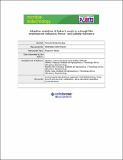Por favor, use este identificador para citar o enlazar a este item:
http://hdl.handle.net/10261/21581COMPARTIR / EXPORTAR:
 SHARE SHARE
 CORE
BASE CORE
BASE
|
|
| Visualizar otros formatos: MARC | Dublin Core | RDF | ORE | MODS | METS | DIDL | DATACITE | |

| Título: | Adaptive evolution of baker's yeast in a dough-like environment enhances freeze and salinity tolerance |
Autor: | Aguilera, Jaime CSIC; Andreu, Pasqual CSIC; Rández Gil, Francisca CSIC ORCID; Prieto Alamán, José Antonio CSIC ORCID | Palabras clave: | Yeast Freeze tolerance Salinity tolerance Adaptive evolution |
Fecha de publicación: | mar-2010 | Editor: | Blackwell Publishing Society for Applied Microbiology |
Citación: | Microbial Biotechnology 3 (2): 210-221 (2010) | Resumen: | We used adaptive evolution to improve freeze tolerance of industrial baker's yeast. Our hypothesis was that adaptation to low temperature is accompanied by enhanced resistance of yeast to freezing. Based on this hypothesis, yeast was propagated in a flour-free liquid dough model system, which contained sorbitol and NaCl, by successive batch refreshments maintained constantly at 12°C over at least 200 generations. Relative to the parental population, the maximal growth rate (µmax) under the restrictive conditions, increased gradually over the time course of the experiment. This increase was accompanied by enhanced freeze tolerance. However, these changes were not the consequence of genetic adaptation to low temperature, a fact that was confirmed by prolonged selection of yeast cells in YPD at 12°C. Instead, the experimental populations showed a progressive increase in NaCl tolerance. This phenotype was likely achieved at the expense of others traits, since evolved cells showed a ploidy reduction, a defect in the glucose derepression mechanism and a loss in their ability to utilize gluconeogenic carbon sources. We discuss the genetic flexibility of S. cerevisiae in terms of adaptation to the multiple constraints of the experimental design applied to drive adaptive evolution and the technologically advantageous phenotype of the evolved population. | Descripción: | 12 pages, 7 figures, 2 tables.-- Online version published: 17 Jul 2009.-- The definitive version is available at www3.interscience.wiley.com | Versión del editor: | http://dx.doi.org/10.1111/j.1751-7915.2009.00136.x | URI: | http://hdl.handle.net/10261/21581 | DOI: | 10.1111/j.1751-7915.2009.00136.x | ISSN: | 1751-7907 |
| Aparece en las colecciones: | (IATA) Artículos |
Ficheros en este ítem:
| Fichero | Descripción | Tamaño | Formato | |
|---|---|---|---|---|
| Aguilera-Microbial Biotechnology.pdf | 1,62 MB | Adobe PDF |  Visualizar/Abrir |
CORE Recommender
PubMed Central
Citations
11
checked on 05-mar-2024
SCOPUSTM
Citations
26
checked on 16-abr-2024
WEB OF SCIENCETM
Citations
26
checked on 26-feb-2024
Page view(s)
370
checked on 19-abr-2024
Download(s)
297
checked on 19-abr-2024
Google ScholarTM
Check
Altmetric
Altmetric
Artículos relacionados:
NOTA: Los ítems de Digital.CSIC están protegidos por copyright, con todos los derechos reservados, a menos que se indique lo contrario.
